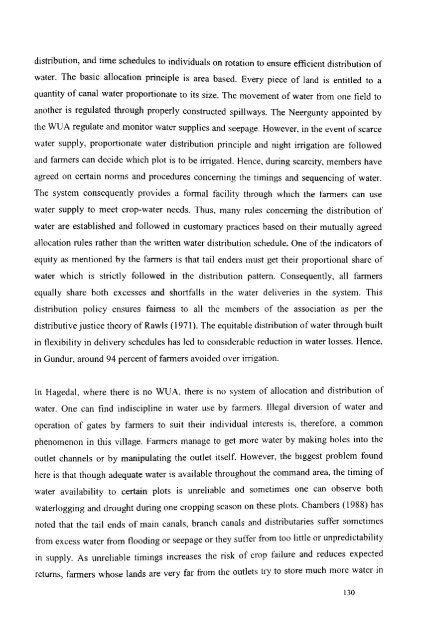Water Users Association and Irrigation Management - Institute for ...
Water Users Association and Irrigation Management - Institute for ...
Water Users Association and Irrigation Management - Institute for ...
You also want an ePaper? Increase the reach of your titles
YUMPU automatically turns print PDFs into web optimized ePapers that Google loves.
distribution, <strong>and</strong> time schedules to individuals on rotation to ensure efficient distribution of<br />
water. The basic allocation principle is area based. Every piece of l<strong>and</strong> is entitled to a<br />
quantity of canal water proportionate to its size. The movement of water from one tield to<br />
another is regulated through properly constructed spillways. The Neergunty appointed by<br />
the WUA regulate <strong>and</strong> monitor water supplies <strong>and</strong> seepage. However, in the event of scarce<br />
water supply, proportionate water distribution principle <strong>and</strong> night irrigation are followed<br />
<strong>and</strong> farmers can decide which plot is to be irrigated. Hence, during scarcity, members have<br />
agreed on certain norms <strong>and</strong> procedures concerning the timings <strong>and</strong> sequencing of water.<br />
The system consequently provides a <strong>for</strong>mal facility through which the farmers can use<br />
water supply to meet crop-water needs. Thus, many rules concerning the distribution of<br />
water are established <strong>and</strong> followed in customary practices based on their mutually agreed<br />
allocation rules rather than the written water distribution schedule. One of the indicators of<br />
equity as mentioned by the farmers is that tail enders must get their proportional share of<br />
water which is strictly followed in the distribution pattern. Consequently, all farmers<br />
equally share both excesses <strong>and</strong> shortfalls in the water deliveries in the system. This<br />
distribution policy ensures fairness to all the members of the association as per the<br />
distributive justice theory of Rawls (1971). The equitable distribution of water through built<br />
in flexibility in delivery schedules has led to considerable reduction in water losses. Hence,<br />
in Gundur, around 94 percent of farmers avoided over irrigation.<br />
In Hagedal, where there is no WUA, there is no system of allocation <strong>and</strong> distribution of<br />
water. One can find indiscipline in water use by farmers. Illegal diversion of water <strong>and</strong><br />
operation of gates by farmers to suit their individual interests is, there<strong>for</strong>e, a common<br />
phenomenon in this village. Farmers manage to get more water by making holes into the<br />
outlet channels or by manipulating the outlet itself. However, the biggest problem found<br />
here is that though adequate water is available throughout the comm<strong>and</strong> area, the timing of<br />
water availability to certain plots is unreliable <strong>and</strong> sometimes one can observe both<br />
waterlogging <strong>and</strong> drought during one cropping season on these plots. Chambers (1988) has<br />
noted that the tail ends of main canals, branch canals <strong>and</strong> distributaries suffer sometimes<br />
from excess water from flooding or seepage or they sutTer from too little or unpredictability<br />
in supply. As unreliable timings increases the risk of crop failure <strong>and</strong> reduces expected<br />
returns, farmers whose l<strong>and</strong>s are very far from the outlets try to store much more water in<br />
130
















